
Cambridge - Its Railways and Station[Source:
Darren Kitson]
Part 2: The Pre-Grouping Period (continued)
The main engine shed at Cambridge was, of course, that of the GER. As we have already seen, it was opened by the ECR as a 4-road shed in 1847 having replaced the original 1845 ECR shed which was located east of the station, and opposite what was then the north end of the platform. Under the auspices of the GER, the 1847 shed was extended to 7-roads in 1913 and stores buildings were erected to its west. The 1913 extension differed to the original part of the shed in that it had a northlight roof. There was, of course, a turntable of 55ft, and in 1934 the LNER erected a mechanical coaling plant and, previously in 1931, had made further alterations to the shed. The shed remained essentially in its 1913 condition until it closed on 18 June 1962, coded 31A. Its peak was in 1923 when some 170 locomotives were allocated.
Unfortunately photographs of the shed during GER days and which show any detail have proved hard to come by so, as with the previous images, we will use a couple from BR days. That above was taken during October 1960 and shows all seven roads of the post 1913 shed. No.1 road is that on the extreme left. The original 1847 ECR shed comprised No.1 to No.4 roads and is the section with the dilapidated roof. The original roof was a clerestory structure with east-west facing pitches. The 1913 GER addition comprised roads 5, 6 & 7 and this was built with a northlight roof. In 1931 the LNER re-roofed the entire shed into the northlight form as seen above.
The above image was taken in August 1956. On the extreme right the west wall of the engine shed with its post-1931 northlight roof can be seen. To the right of the shed are stores and office buildings, some of which, at the time of writing, still stand but are due for demolition. On the left, taking on water, stands what appears to be a Thompson Class L1 2-6-4T locomotive. In the left background stands an ex-GER Class B12/3 4-6-0 while in the centre is BR Standard Class 5 4-6-0 73071. At this time, Standard 5s were quite common on King's Cross - Cambridge outer suburban trains. Today it is hard to appreciate the former extent of the shed yard; tracks reached south and west into the area bounded by Devonshire Road, Tenison Road and Station Road. Hiding behind the Class 5 appears to be an Austerity 0-6-0ST and a couple of 0-6-0 tender locomotives. In 1875 the GER designated the shed 'CAM' and it remained so until February 1950 when it became 31A under BR. Further pictures of 31A can be seen in the British Railways section. Some of the class were later disfigured by the addition of feed water heaters; 8509 with a Worthington - Simpson design and a further 55 with French ACFI (Societe l'Auxiliaire des Chemins de Fer et de l'Industrie) equipment. One issue which limited where the Class could run was turntable size and in June 1932 one of the ACFI examples, 8526, operated an excursion from Liverpool Street to Mildenhall. This event became well known because the locomotive was only able to be turned at Mildenhall following great difficulty positioning and balancing it on Mildenhall's 50ft turntable. The wheelbase of the B12 was 48ft 3ins. Mildenhall might seem an odd choice of destination for a Sunday, excursion from Liverpool Street in June 1932. Such excursions were commonplace and we must remember that at the time people rarely travelled for leisure purposes as they do today. Indeed, people in rural areas seldom ventured outside their home area unless the railways and bus companies laid on excursions. These excursions therefore provided a cheap means by which people could visit relatives and friends for a day. As train weights increased, the B12s began to prove themselves inadequate and much of their main line work was taken over by Gresley's B17 Class and the later Thompson B1s. Nevertheless, the B12s soldiered on, often on branch lines, until the final example, BR No.61572, was withdrawn in September 1961. She is now preserved at the North Norfolk Railway. The above image is hopelessly out-of-period, being taken in April 2010, but it is appropriate to show it here for comparison purposes. It shows all the is currently left of Cambridge shed, the former stores and office buildings. It is taken from roughly where 73071 is standing in the previous image. Through the gap on the extreme left the car park on the site of the shed proper can just be seen and beyond that the wall at the rear of platform 6. Liverpool Street, St Pancras and the Slip Coaches Until 1923 the GER's Cambridge - Liverpool Street services were competing with the GNR's services to King's Cross. For that reason the GER began running some Cambridge trains to/from St Pancras from 1 July 1870 via the Tottenham & Hampstead line which had opened in July 1868 to Highgate Road High Level* and extended to Kentish Town in 1870. Highgate Road High Level closed in 1915. *Not to be confused with Highgate High Level, the now abandoned station on what was to have become part of the Northern Line under London Transport's 1935 New Works Programme. GER trains to and from St Pancras never totalled more than three or four per day but there were also some connecting shuttles between Tottenham and St Pancras. The GER kept a pilot locomotive at St Pancras; Johnson 4-4-0 No.306, while No.305 of the same type served as Liverpool Street pilot. The Class was the first inside cylinder 4-4-0 type in England and became extinct with the withdrawal of 306 in 1897 and 305 in 1898. Slip coaches were designed to be uncoupled from a moving train and brought to rest under the control of the guard. They gave the advantage of the main portion of the train not needing to make stops at intermediate stations and also avoided the need for extra paths as would be required for separate trains. 'Paths', in railway parlance, are slots in which trains can run over a given length of track and the number of available paths is dictated by signalling, line speed, types of trains, where trains do and do not stop and so on. When all paths have been allocated, the line concerned is said to be 'at capacity'. Disadvantages with slip coaches were many, the most obvious being that they could only be used in one direction - it not being possible to attach coaches to moving trains. The usual procedure in the 'reverse' direction was for the slip coaches to operate as a local train before being later coupled to another train at a place where the latter was timetabled to stop. All this was time consuming, with locomotive movements and shunting being necessary. Other disadvantages were the need to have a guard on the main portion of a train as well as one on each coach to be slipped and also the need to have locomotives standing by to quickly remove or take forward the slipped coaches. A degree of skill was also required of a slip coach guard in order to bring his coach to rest at the correct place. Slipping usually worked as planned but on rare occasions the uncoupling failed to work; in these cases the whole train had to be brought to a standstill and the problem attended to. Apart from the through Cambridge - St Pancras trains, some Cambridge - Liverpool Street trains slipped coaches for St Pancras at Tottenham. Other Cambridge trains, including the York services, slipped coaches at Broxbourne for Hertford East. Today, some peak hour electric multiple unit trains divide at Cambridge, among other places, and of course passengers need to ensure they in the correct portion of the train. The same applied in the days of slip coaches; when an inattentive passenger from Cambridge, for example, might have thought he was going to Liverpool Street but ended up at St Pancras. Commencing in October 1914, coaches were also slipped from two down Cambridge trains during the evening peak at Newport for forwarding to Saffron Walden. In the up direction, two trains in the morning peak stopped at Newport for coaches from Saffron Walden to be attached. Newport was used to avoid the additional shunting at Audley End, due to the junction with the Saffron Walden branch being south of the station and trailing in the up direction. Presumably the coaches slipped in the evening were the same ones as were attached in the morning. This, of course, would have involved much shunting - especially at the London end to ensure the slip coaches were at the rear of the down trains. What remains unclear is whether the coaches slipped from down trains were brought to a halt in Newport station or if they were allowed to coast to a point south of Audley End Junction. The Saffron Walden slips lasted for only a very short time and in the absence of the relevant timetable the precise arrangements are unknown. Either way, the whole business illustrates well the operating nuisance posed by slip coaches although they were convenient for passengers and did save some locomotive mileage. The last slip coaches out of Liverpool Street ran in 1938; one at Waltham Cross and a pair at Marks Tey. The Great Western Railway, however, was a fan of slip coaches and what had become the Western Region of BR saw the last slip coach in Britain - at Bicester North on 10 September 1960. The Oil Burning Locomotives of the GER
Above is Claud Hamilton 4-4-0 No.1858 at Cambridge in 1905. The first of these locomotives appeared in 1900, numbered 1900 and named Claud Hamilton after the GER Chairman of that name. James Holden deliberately numbered the first example 1900 to signify the year it was built and successive builds were numbered in reverse order; therefore the lowest numbered example was the newest, not the oldest. A total of 121 were built, numbered down to 1780 with the last being built in 1923 under the LNER. To add to the confusion, 1900 was scrapped in 1947 but the nameplates were transferred to 1855 (later renumbered 8855, then 2546) which survived to become BR No.62546 and was withdrawn in June 1957. No less than 117 Clauds, as they came to be known, survived into BR days; 14 being of Class D15 and the remainder Class D16. Apart from eight Clauds which were sent to Cheshire in 1949 where, by all accounts, they were well liked, the class remained in its native area although under BR they could appear as far west as Oxford (on trains from Cambridge) and also on Cambridge - King's Cross trains. The final example survived until September 1960; 62613 at March depot, 31B. No.1858 was new in 1904 and she was an oil burner; one of the last batch of ten to be so built, the others being conversions. Fuel oil was carried in two tanks on the tender; these tanks and associated pipework being additions to what was otherwise a standard tender. The GER had an oil-gas plant at Stratford, producing gas for carriage lighting. The waste from this process was a tar-like substance which the GER had been dumping in the Channelsea River which fed into the River Lea. This caused controversy and the GER's James Holden came up with the idea of using the waste as locomotive fuel. The design allowed for easy fitting of the oil burning equipment as well as easy removal should coal firing be reverted to. The oil burning locomotives still had to be primed with a coal fire and the fuel had to be heated in cold weather to keep it fluid. The latter was achieved by heating coils in the tanks fed with exhaust steam from the Westinghouse pump or, once steam had been raised to a certain pressure, by steam direct from the boiler. A valve on the footplate controlled the firebox burners and could also be set to clean out the burners and pipework with steam. Some 60 locomotives were fitted with oil burning equipment and proved to be 100% successful. There is a well known story concerning one of the oil burners, T19 Class 2-4-0 No.761. On 15 June 1894 she worked an excursion train for Bass, the brewers, from St Pancras to Scarborough and back. This ran via Cambridge and the GN&GE Joint Line, a total of 510 miles. Reserve oil was carried in cans onboard the train just in case but in the event was not needed; 761 arrived back at St Pancras with fuel to spare. Surviving details of oil producing plants are a little patchy but it appears the sole GER plant was that at Stratford, with oil either piped or sent in tank wagons to other sites which required it. Quite how this thick, tar-like substance was sent via pipeline, especially during cold periods, is not clear. To date, no evidence of any facilities for oil burning locomotives at Cambridge has come to light but locomotives so fitted are known to have been a common sight at Cambridge. Given the mileage these locomotives could achieve without needing to refuel, it is likely no facilities were actually needed at Cambridge. Stratford, after all, is not too far away
Above T19 No.761 is seen, the locomotive involved in the Scarborough excursion. The oil fuel tanks were very prominent on the GER's low-sided tenders. There were a number of different designs of oil tank but it appears the type seen above became standard.
Above is P43 Class locomotive No.10. Ten of these attractive machines, numbered 10 to 19, were built at Stratford in 1898 and all were oil burners. They were not among James Holden's better decisions. The tender was of the type known as 'water cart' and the oil tanks were far less prominent. The locomotive design was similar to those produced by the Midland and Great Western railways but by the time the P43 appeared the 4-2-2 single-driver design was obsolete. The use of a large single-driver was intended for speed but tractive effort (force of driving wheels against rail, usually measure in pounds) was poor and adhesion (wheel to rail grip) virtually non existent with anything but the lightest trains on dry rails. All this at a time when train weights were becoming increasingly heavier. The P43s were fitted with steam sanding gear but even so the class was eclipsed by the Clauds and spent most of its dismally short life pottering around the flat GN&GE Joint Line, following a spell on the Cromer expresses. All had gone by 1910. The locations in the two images above are not known but they appear to be GER official photographs, so were most likely taken at Stratford.
Click here to continue Part 2: The Pre-Grouping Period
|
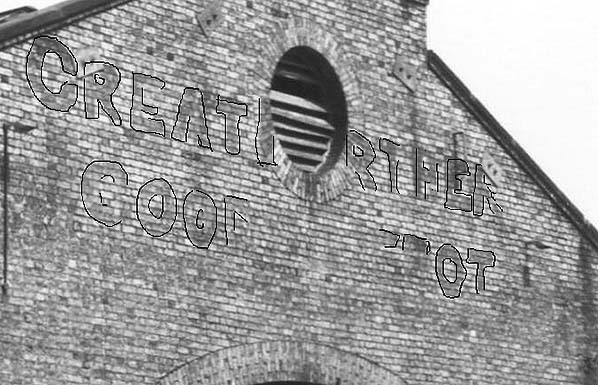
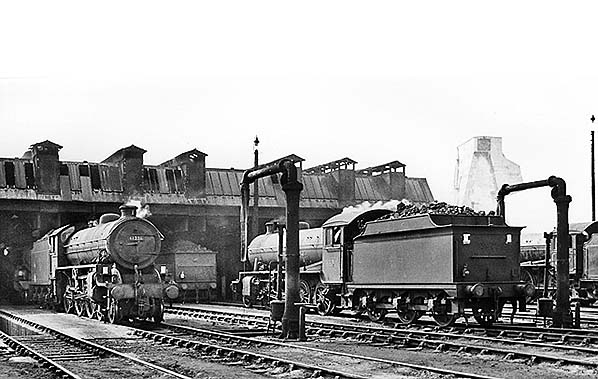
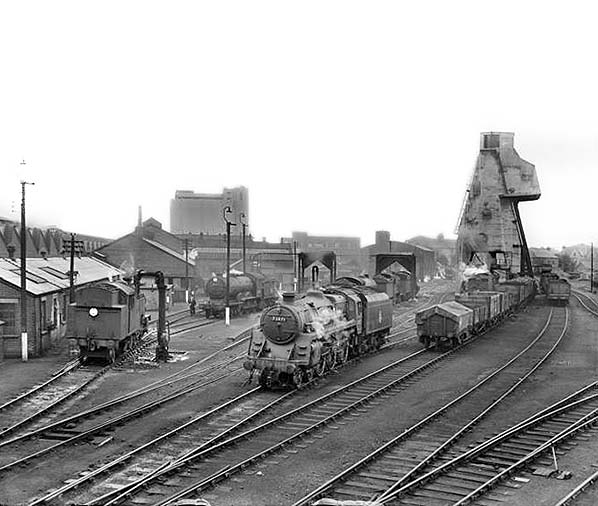
 The B12 locomotives were in essence a stretched Claud and were introduced under the tenure of Stephen Holden, James Holden's son, in 1911. Intended as a short wheelbase, lightweight type they could be seen on much of the GER system. Some eventually migrated to Scotland. By all accounts, Stephen Holden fell a long way short of his father's experience and expertise and the B12s were more the result of the expertise of Stratford drawing office than of Stephen Holden. Known as the S69 Class under the GER, the B12s were fairly capable yet compact, being comparable in size to 4-4-0 machines of other companies. Rebuilds with larger boilers began in the 1930s and this gave the type a rather top heavy, yet not ungainly, appearance. The rebuilt machines became Class B12/3. As with the Clauds, the design of the running plates and splashers, notwithstanding being simplified over the years, gave the locomotives a slightly antiquated appearance as time progressed. This was, however, far surpassed by the ancient locomotives of the Midland Railway which arrived at Cambridge off the Kettering line; their use being necessitated by the weak wooden trestle bridges between St Ives and Huntingdon.
The B12 locomotives were in essence a stretched Claud and were introduced under the tenure of Stephen Holden, James Holden's son, in 1911. Intended as a short wheelbase, lightweight type they could be seen on much of the GER system. Some eventually migrated to Scotland. By all accounts, Stephen Holden fell a long way short of his father's experience and expertise and the B12s were more the result of the expertise of Stratford drawing office than of Stephen Holden. Known as the S69 Class under the GER, the B12s were fairly capable yet compact, being comparable in size to 4-4-0 machines of other companies. Rebuilds with larger boilers began in the 1930s and this gave the type a rather top heavy, yet not ungainly, appearance. The rebuilt machines became Class B12/3. As with the Clauds, the design of the running plates and splashers, notwithstanding being simplified over the years, gave the locomotives a slightly antiquated appearance as time progressed. This was, however, far surpassed by the ancient locomotives of the Midland Railway which arrived at Cambridge off the Kettering line; their use being necessitated by the weak wooden trestle bridges between St Ives and Huntingdon.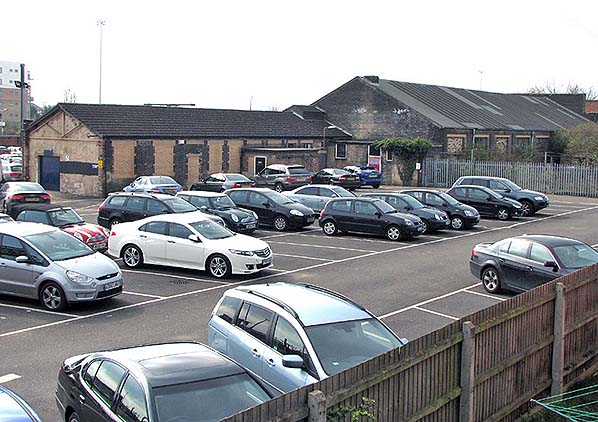
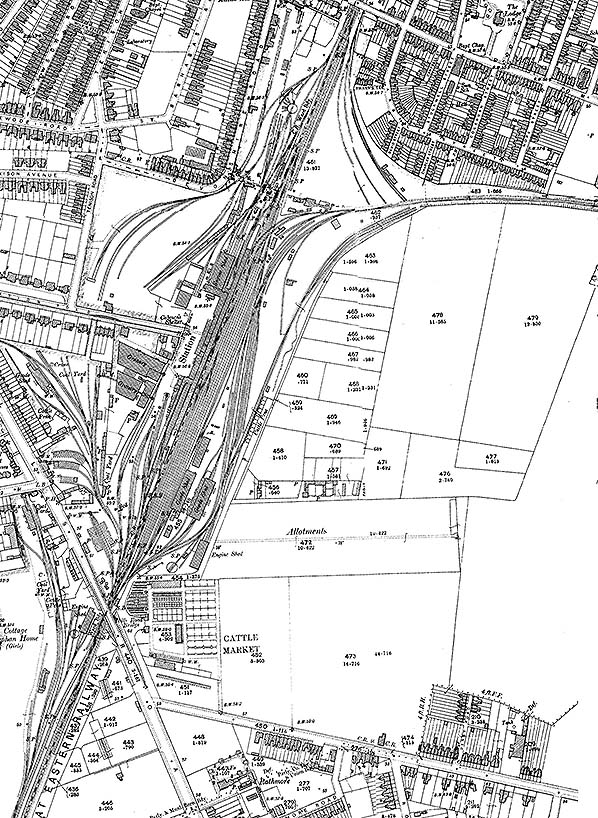
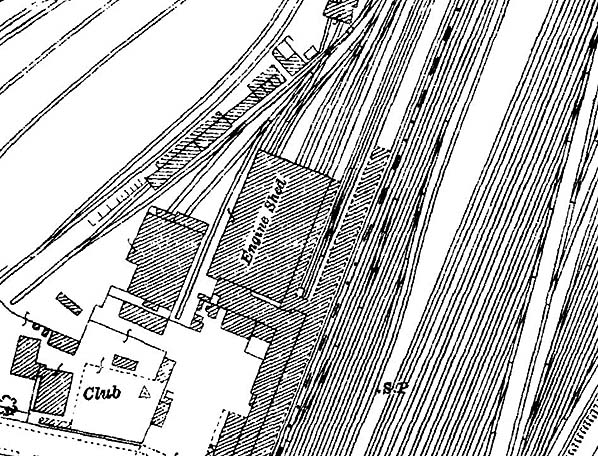
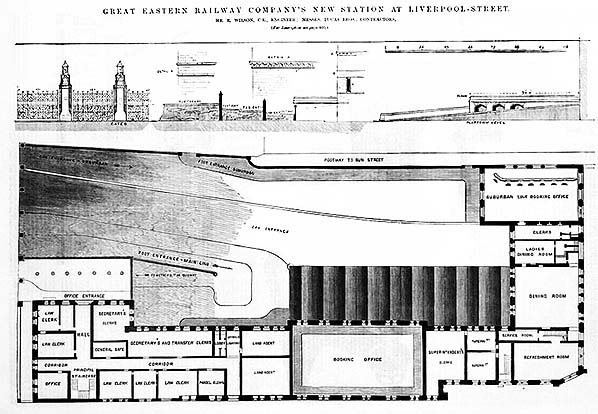
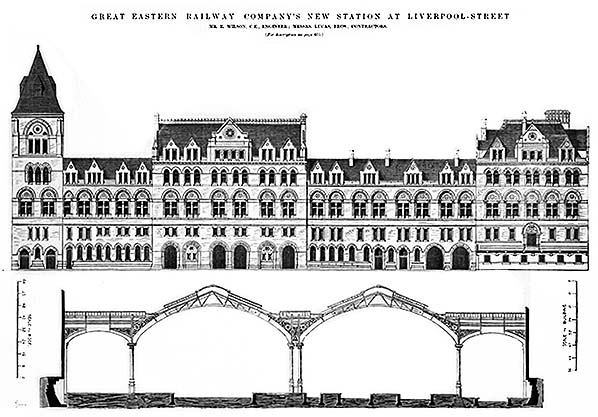
 The GER St Pancras services offered some of the fastest trains to and from Cambridge; the quickest taking 71 minutes. Not bad at all for the time, especially when considering it included the amble over the Tottenham & Hampstead. However, any one-upmanship over the GNR was lost because St Pancras trains continued beyond Cambridge and divided at Ely for other destinations. This meant duplication of services, lost time at Ely and extra locomotive movements. In other words, what was gained south of Cambridge was lost further north. St Pancras services were suspended during the First World War [the same wartime economy measures which saw the closure of Highgate Road High Level] but reinstated rather half-heartedly afterwards. These reinstated trains were withdrawn altogether in 1922. In the event, the following year the GER and GNR became part of the newly formed LNER and with this the reason for the introduction of the St Pancras services disappeared anyway.
The GER St Pancras services offered some of the fastest trains to and from Cambridge; the quickest taking 71 minutes. Not bad at all for the time, especially when considering it included the amble over the Tottenham & Hampstead. However, any one-upmanship over the GNR was lost because St Pancras trains continued beyond Cambridge and divided at Ely for other destinations. This meant duplication of services, lost time at Ely and extra locomotive movements. In other words, what was gained south of Cambridge was lost further north. St Pancras services were suspended during the First World War [the same wartime economy measures which saw the closure of Highgate Road High Level] but reinstated rather half-heartedly afterwards. These reinstated trains were withdrawn altogether in 1922. In the event, the following year the GER and GNR became part of the newly formed LNER and with this the reason for the introduction of the St Pancras services disappeared anyway.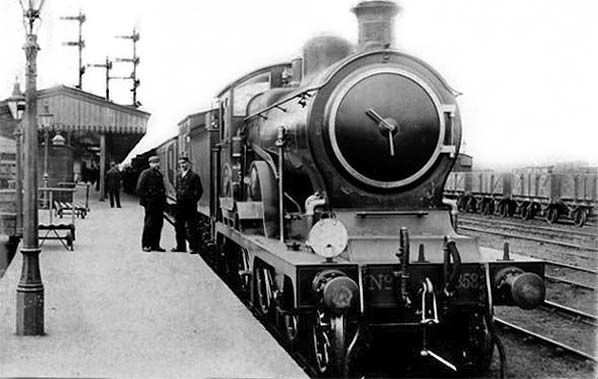
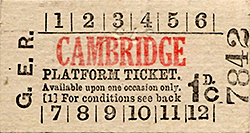 Not only did oil burning eliminate the problem of the dumped waste at Stratford, with the installation of water troughs it also allowed non-stop trains to operate between London and the Norfolk coast. Progress, however, was to catch up with Holden. His oil burning locomotives first appeared c1880 and ultimately proved to be victims of their own success. With 60 locomotives ultimately burning oil, the Stratford plant could not keep up with demand and oil had to sourced from outside. Costs rose to the point where coal became cheaper and the oil burners were gradually converted back to coal firing in the years prior to the First World War. There was a number of miners strikes during the 1920s and oil burning made a partial reappearance, but was abandoned entirely by the LNER in 1927.
Not only did oil burning eliminate the problem of the dumped waste at Stratford, with the installation of water troughs it also allowed non-stop trains to operate between London and the Norfolk coast. Progress, however, was to catch up with Holden. His oil burning locomotives first appeared c1880 and ultimately proved to be victims of their own success. With 60 locomotives ultimately burning oil, the Stratford plant could not keep up with demand and oil had to sourced from outside. Costs rose to the point where coal became cheaper and the oil burners were gradually converted back to coal firing in the years prior to the First World War. There was a number of miners strikes during the 1920s and oil burning made a partial reappearance, but was abandoned entirely by the LNER in 1927.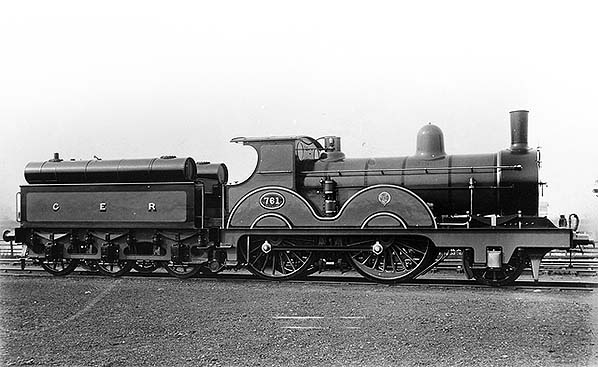
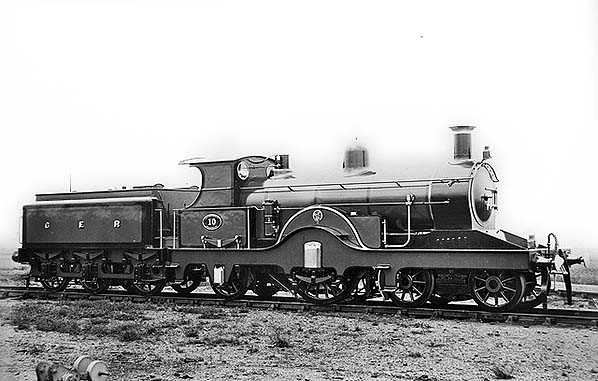
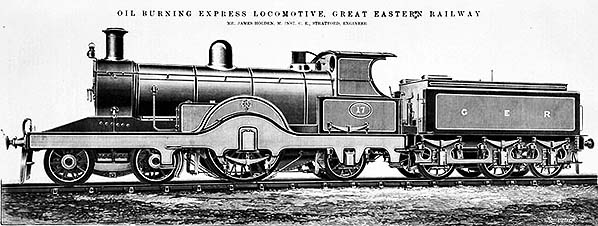

 Home Page
Home Page